Multiresponsive Behavior of Functional Poly(p-phenylene vinylene)s in Water
Abstract
:1. Introduction
2. Experimental
2.1. Materials
2.2. Instrumentation/Methods
2.3. Synthesis and Characterization
2.3.1. Synthesis of 1,4-bis(2-(2-(2-Methoxyethoxy)ethoxy)ethoxy)-2,5-divinylbenzene
2.3.2. Synthesis of PMEE-PDTriG (Figure 1)
2.4. Sample Preparation
3. Results and Discussion
3.1. Synthesis and Characterization
3.2. Responsive Behavior
3.2.1. pH-Responsive Behavior
3.2.2. Thermoresponsive Behavior
3.2.3. UCST-Like Behavior with Calcium(II) Ions
4. Conclusions
Acknowledgments
Author Contributions
Conflicts of Interest
References
- Schmaljohann, D. Thermo- and pH-responsive polymers in drug delivery. Adv. Drug Deliv. Rev. 2006, 58, 1655–1670. [Google Scholar] [CrossRef] [PubMed]
- Mura, S.; Nicolas, J.; Couvreur, P. Stimuli-responsive nanocarriers for drug delivery. Nat. Mater. 2013, 12, 991–1003. [Google Scholar] [CrossRef] [PubMed]
- Yin, L.Y.; He, C.S.; Huang, C.S.; Zhu, W.P.; Wang, X.; Xu, Y.F.; Qian, X.H. A dual pH and temperature responsive polymeric fluorescent sensor and its imaging application in living cells. Chem. Commun. 2012, 48, 4486–4488. [Google Scholar] [CrossRef] [PubMed]
- Bao, Y.Y.; De Keersmaecker, H.; Corneillie, S.; Yu, F.; Mizuno, H.; Zhang, G.F.; Hofkens, J.; Mendrek, B.; Kowalczuk, A.; Smet, M. Tunable ratiometric fluorescence sensing of intracellular pH by aggregation-induced emission-active hyperbranched polymer nanoparticles. Chem. Mater. 2015, 27, 3450–3455. [Google Scholar] [CrossRef]
- Peng, H.S.; Stolwijk, J.A.; Sun, L.N.; Wegener, J.; Wolfbeis, O.S. A nanogel for ratiometric fluorescent sensing of intracellular pH values. Angew. Chem. Int. Ed. 2010, 49, 4246–4249. [Google Scholar] [CrossRef] [PubMed]
- Li, K.; Liu, B. Water-soluble conjugated polymers as the platform for protein sensors. Polym. Chem. 2010, 1, 252–259. [Google Scholar] [CrossRef]
- Pietsch, C.; Hoogenboom, R.; Schubert, U.S. Soluble polymeric dual sensor for temperature and pH value. Angew. Chem. Int. Ed. 2009, 48, 5653–5656. [Google Scholar] [CrossRef] [PubMed]
- Zhu, C.; Liu, L.; Yang, Q.; Lv, F.; Wang, S. Water-soluble conjugated polymers for imaging, diagnosis, and therapy. Chem. Rev. 2012, 112, 4687–4735. [Google Scholar] [CrossRef] [PubMed]
- Cabane, E.; Zhang, X.Y.; Langowska, K.; Palivan, C.G.; Meier, W. Stimuli-responsive polymers and their applications in nanomedicine. Biointerphases 2012, 7, 9. [Google Scholar] [CrossRef] [PubMed] [Green Version]
- Cheng, R.; Meng, F.H.; Deng, C.; Klok, H.A.; Zhong, Z.Y. Dual and multi-stimuli responsive polymeric nanoparticles for programmed site-specific drug delivery. Biomaterials 2013, 34, 3647–3657. [Google Scholar] [CrossRef] [PubMed]
- Gil, E.S.; Hudson, S.M. Stimuli-reponsive polymers and their bioconjugates. Prog. Polym. Sci. 2004, 29, 1173–1222. [Google Scholar] [CrossRef]
- Galaev, I.Y.; Mattiasson, B. “Smart” polymers and what they could do in biotechnology and medicine. Trends Biotechnol. 1999, 17, 335–340. [Google Scholar] [CrossRef]
- Gulur Srinivas, A.R.; Kerr-Phillips, T.E.; Peng, H.; Barker, D.; Travas-Sejdic, J. Water-soluble anionic poly(p-phenylene vinylenes) with high luminescence. Polym. Chem. 2013, 4, 2506–2514. [Google Scholar] [CrossRef]
- Enzenberg, A.; Laschewsky, A.; Boeffel, C.; Wischerhoff, E. Influence of the near molecular vicinity on the temperature regulated fluorescence response of poly(N-vinylcaprolactam). Polymers 2016, 8, 109. [Google Scholar] [CrossRef]
- Zhang, Q.L.; Vancoillie, G.; Mees, M.A.; Hoogenboom, R. Thermoresponsive polymeric temperature sensors with broad sensing regimes. Polym. Chem. 2015, 6, 2396–2400. [Google Scholar] [CrossRef]
- Pietsch, C.; Vollrath, A.; Hoogenboom, R.; Schubert, U.S. A fluorescent thermometer based on a pyrene-labeled thermoresponsive polymer. Sensors 2010, 10, 7979–7990. [Google Scholar] [CrossRef] [PubMed] [Green Version]
- Uchiyama, S.; Kawai, N.; De Silva, A.P.; Iwai, K. Fluorescent polymeric AND logic gate with temperature and pH as inputs. J. Am. Chem. Soc. 2004, 126, 3032–3033. [Google Scholar] [CrossRef] [PubMed]
- Jin, Q.A.; Liu, G.Y.; Ji, J.A. Micelles and reverse micelles with a photo and thermo double-responsive block copolymer. J. Polym. Sci. Polym. Chem. 2010, 48, 2855–2861. [Google Scholar] [CrossRef]
- Uchiyama, S.; Makino, Y. Digital fluorescent pH sensors. Chem. Commun. 2009, 19, 2646–2648. [Google Scholar] [CrossRef] [PubMed]
- Korostynska, O.; Arshak, K.; Gill, E.; Arshak, A. Review on state-of-the-art in polymer based pH sensors. Sensors 2007, 7, 3027–3042. [Google Scholar] [CrossRef]
- Wang, S. Dopamine modified cationic conjugated polymers as a new platform for pH sensing and autophagy imaging. Adv. Funct. Mater. 2013, 23, 764–769. [Google Scholar]
- Gota, C.; Uchiyama, S.; Ohwada, T. Accurate fluorescent polymeric thermometers containing an ionic component. Analyst 2007, 132, 121–126. [Google Scholar] [CrossRef] [PubMed]
- Wang, X.-D.; Wolfbeis, O.S.; Meier, R.J. Luminescent probes and sensors for temperature. Chem. Soc. Rev. 2013, 42, 7834–7869. [Google Scholar] [CrossRef] [PubMed]
- Khine, Y.Y.; Jiang, Y.Y.; Dag, A.; Lu, H.X.; Stenzel, M.H. Dual-responsive pH and temperature sensitive nanoparticles based on methacrylic acid and Di(ethylene glycol) methyl ether methacrylate for the triggered release of drugs. Macromol. Biosci. 2015, 15, 1091–1104. [Google Scholar] [CrossRef] [PubMed]
- Wang, X.D.; Meier, R.J.; Wolfbeis, O.S. A fluorophore-doped polymer nanomaterial for referenced imaging of pH and temperature with sub-micrometer resolution. Adv. Funct. Mater. 2012, 22, 4202–4207. [Google Scholar] [CrossRef]
- McQuade, D.T.; Pullen, A.E.; Swager, T.M. Conjugated polymer-based chemical sensors. Chem. Rev. 2000, 100, 2537–2574. [Google Scholar] [CrossRef] [PubMed]
- Feng, X.L.; Liu, L.B.; Wang, S.; Zhu, D.B. Water-soluble fluorescent conjugated polymers and their interactions with biomacromolecules for sensitive biosensors. Chem. Soc. Rev. 2010, 39, 2411–2419. [Google Scholar] [CrossRef] [PubMed]
- Aydemir, N.; Malmstrom, J.; Travas-Sejdic, J. Conducting polymer based electrochemical biosensors. Phys. Chem. Chem. Phys. 2016, 18, 8264–8277. [Google Scholar] [CrossRef] [PubMed]
- Zhu, B.; Alsager, O.A.; Kumar, S.; Hodgkiss, J.M.; Travas-Sejdic, J. Label-free electrochemical aptasensor for femtomolar detection of 17 β-estradiol. Biosens. Bioelectron. 2015, 70, 398–403. [Google Scholar] [CrossRef] [PubMed]
- Liu, B.; Bazan, G.C. Homogeneous fluorescence-based DNA detection with water-soluble conjugated polymers. Chem. Mater. 2004, 16, 4467–4476. [Google Scholar] [CrossRef]
- Gaylord, B.S.; Heeger, A.J.; Bazan, G.C. DNA detection using water-soluble conjugated polymers and peptide nucleic acid probes. Proc. Natl. Acad. Sci. USA 2002, 99, 10954–10957. [Google Scholar] [CrossRef] [PubMed]
- Jadranka, T.-S.; AnupamaRaoGulur, S. Optical gene detection using conjugated polymers. In Optical Properties of Functional Polymers and Nano Engineering Applications; CRC Press: Boca Raton, FL, USA, 2014; pp. 61–86. [Google Scholar]
- Srinivas, A.R.G.; Peng, H.; Barker, D.; Travas-Sejdic, J. Switch on or switch off: An optical DNA sensor based on poly(p-phenylenevinylene) grafted magnetic beads. Biosens. Bioelectron. 2012, 35, 498–502. [Google Scholar] [CrossRef] [PubMed]
- Srinivas, A.R.G.; Barker, D.; Travas-Sejdic, J. “Switch-on” DNA sensor based on poly (p-phenylene vinylenes) bound tentacle probes. Pure Appl. Chem. 2015, 87, 707–715. [Google Scholar] [CrossRef]
- Giepmans, B.N.G.; Adams, S.R.; Ellisman, M.H.; Tsien, R.Y. Review—The fluorescent toolbox for assessing protein location and function. Science 2006, 312, 217–224. [Google Scholar] [CrossRef] [PubMed]
- Fan, C.H.; Plaxco, K.W.; Heeger, A.J. High-efficiency fluorescence quenching of conjugated polymers by proteins. J. Am. Chem. Soc. 2002, 124, 5642–5643. [Google Scholar] [CrossRef] [PubMed]
- Zhang, W.; Sun, H.; Yin, S.Y.; Chang, J.J.; Li, Y.H.; Guo, X.Y.; Yuan, Z. Bright red-emitting polymer dots for specific cellular imaging. J. Mater. Sci. 2015, 50, 5571–5577. [Google Scholar] [CrossRef]
- Thomas, S.W.; Joly, G.D.; Swager, T.M. Chemical sensors based on amplifying fluorescent conjugated polymers. Chem. Rev. 2007, 107, 1339–1386. [Google Scholar] [CrossRef] [PubMed]
- Lakowicz, J.R. Principles of Fluorescence Spectroscopy, 2nd ed.; Plenm: New York, NY, USA, 1999. [Google Scholar]
- Tan, C.Y.; Alas, E.; Muller, J.G.; Pinto, M.R.; Kleiman, V.D.; Schanze, K.S. Amplified quenching of a conjugated polyelectrolyte by cyanine dyes. J. Am. Chem. Soc. 2004, 126, 13685–13694. [Google Scholar] [CrossRef] [PubMed]
- Kim, I.B.; Dunkhorst, A.; Gilbert, J.; Bunz, U.H.F. Sensing of lead ions by a carboxylate-substituted PPE: Multivalency effects. Macromolecules 2005, 38, 4560–4562. [Google Scholar] [CrossRef]
- Jiang, H.; Zhao, X.Y.; Schanze, K.S. Amplified fluorescence quenching of a conjugated polyelectrolyte mediated by Ca2+. Langmuir 2006, 22, 5541–5543. [Google Scholar] [CrossRef] [PubMed]
- Nilsson, K.P.R.; Inganas, O. Optical emission of a conjugated polyelectrolyte: Calcium-induced conformational changes in calmodulin and calmodulin–calcineurin interactions. Macromolecules 2004, 37, 9109–9113. [Google Scholar] [CrossRef]
- Vancoillie, G.; Frank, D.; Hoogenboom, R. Thermoresponsive poly(oligo ethylene glycol acrylates). Prog. Polym. Sci. 2014, 39, 1074–1095. [Google Scholar] [CrossRef]
- Weber, C.; Hoogenboom, R.; Schubert, U.S. Temperature responsive bio-compatible polymers based on poly(ethylene oxide) and poly(2-oxazoline)s. Prog. Polym. Sci. 2012, 37, 686–714. [Google Scholar] [CrossRef]
- Lutz, J.F. Thermo-switchable materials prepared using the OEGMA-platform. Adv. Mater. 2011, 23, 2237–2243. [Google Scholar] [CrossRef]
- Seuring, J.; Agarwal, S. Polymers with upper critical solution temperature in aqueous solution. Macromol. Rapid Commun. 2012, 33, 1898–1920. [Google Scholar] [CrossRef] [PubMed]
- Zhang, Q.L.; Hoogenboom, R. Polymers with upper critical solution temperature behavior in alcohol/water solvent mixtures. Prog. Polym. Sci. 2015, 48, 122–142. [Google Scholar] [CrossRef]
- Plamper, F.A.; Schmalz, A.; Ballauff, M.; Muller, A.H.E. Tuning the thermoresponsiveness of weak polyelectrolytes by pH and light: Lower and upper critical-solution temperature of poly(N,N-dimethylaminoethyl methacrylate). J. Am. Chem. Soc. 2007, 129, 14538–14539. [Google Scholar] [CrossRef] [PubMed]
- Ott, C.; Hoogenboom, R.; Hoeppener, S.; Wouters, D.; Gohy, J.F.; Schubert, U.S. Tuning the morphologies of amphiphilic metallo-supramolecular triblock terpolymers: From spherical micelles to switchable vesicles. Soft Matter 2009, 5, 84–91. [Google Scholar] [CrossRef]
- Jia, X.; Chen, D.Y.; Jiang, M. Preparation of PEO-b-P2VPH(+)-S2O82− micelles in water and their reversible UCST and redox-responsive behavior. Chem. Commun. 2006, 16, 1736–1738. [Google Scholar] [CrossRef] [PubMed]
- Serp, D.; Mueller, M.; von Stockar, U.; Marison, I.W. Low-temperature electron microscopy for the study of polysaccharide ultrastructures in hydrogels. II. Effect of temperature on the structure of Ca2+-alginate beads. Biotechnol. Bioeng. 2002, 79, 253–259. [Google Scholar] [CrossRef] [PubMed]
- Pawar, S.N.; Edgar, K.J. Alginate derivatization: A review of chemistry, properties and applications. Biomaterials 2012, 33, 3279–3305. [Google Scholar] [CrossRef] [PubMed]
- Morch, Y.A.; Donati, I.; Strand, B.L.; Skjak-Braek, G. Effect of Ca2+, Ba2+, and Sr2+ on alginate microbeads. Biomacromolecules 2006, 7, 1471–1480. [Google Scholar] [CrossRef] [PubMed]
- De Silva, A.P.; Gunaratne, H.Q.N.; Gunnlaugsson, T.; Huxley, A.J.M.; McCoy, C.P.; Rademacher, J.T.; Rice, T.E. Signaling recognition events with fluorescent sensors and switches. Chem. Rev. 1997, 97, 1515–1566. [Google Scholar] [CrossRef] [PubMed]
- Van Severen, I.; Breselge, M.; Fourier, S.; Adriaensens, P.; Manca, J.; Lutsen, L.; Cleij, T.J.; Vanderzande, D. 2,5-substituted PPV-derivatives with different polarities: The effect of side chain polarity on solubility, optical and electronic properties. Macromol. Chem. Phys. 2007, 208, 196–206. [Google Scholar] [CrossRef]
- Lee, K.; Kim, H.J.; Kim, J. Design principle of conjugated polyelectrolytes to make them water-soluble and highly emissive. Adv. Funct. Mater. 2012, 22, 1076–1086. [Google Scholar] [CrossRef] [Green Version]
- Sambe, L.; De La Rosa, V.R.; Belal, K.; Stoffelbach, F.; Lyskawa, J.; Delattre, F.; Bria, M.; Cooke, G.; Hoogenboom, R.; Woisel, P. Programmable polymer-based supramolecular temperature sensor with a memory function. Angew. Chem. Int. Ed. 2014, 53, 5044–5048. [Google Scholar]
- De la Rosa, V.R.; Hoogenboom, R. Solution polymeric optical temperature sensors with long-term memory function powered by supramolecular chemistry. Chem. Eur. J. 2015, 21, 1302–1311. [Google Scholar] [CrossRef] [PubMed]
- Custers, J.P.A.; van Nispen, S.F.G.M.; Can, A.; De la Rosa, V.R.; Maji, S.; Schubert, U.S.; Keurentjes, J.T.F.; Hoogenboom, R. Reversible calcium(II)-ion binding through an apparent pK(a) shift of thermosensitive block-copolymer micelles. Angew. Chem. Int. Ed. 2015, 54, 14085–14089. [Google Scholar] [CrossRef] [PubMed]
- Custers, J.P.A.; Kelemen, P.; Van den Broeke, L.J.P.; Stuart, M.A.C.; Keurentjes, J.T.F. Reversible binding of multivalent ions by surfactant self-assembly. J. Am. Chem. Soc. 2005, 127, 1594–1595. [Google Scholar] [CrossRef] [PubMed]
- Mahou, R.; Tran, N.M.; Dufresne, M.; Legallais, C.; Wandrey, C. Encapsulation of Huh-7 cells within alginate-poly(ethylene glycol) hybrid microspheres. J. Mater. Sci. Mater. Med. 2012, 23, 171–179. [Google Scholar] [CrossRef] [PubMed]
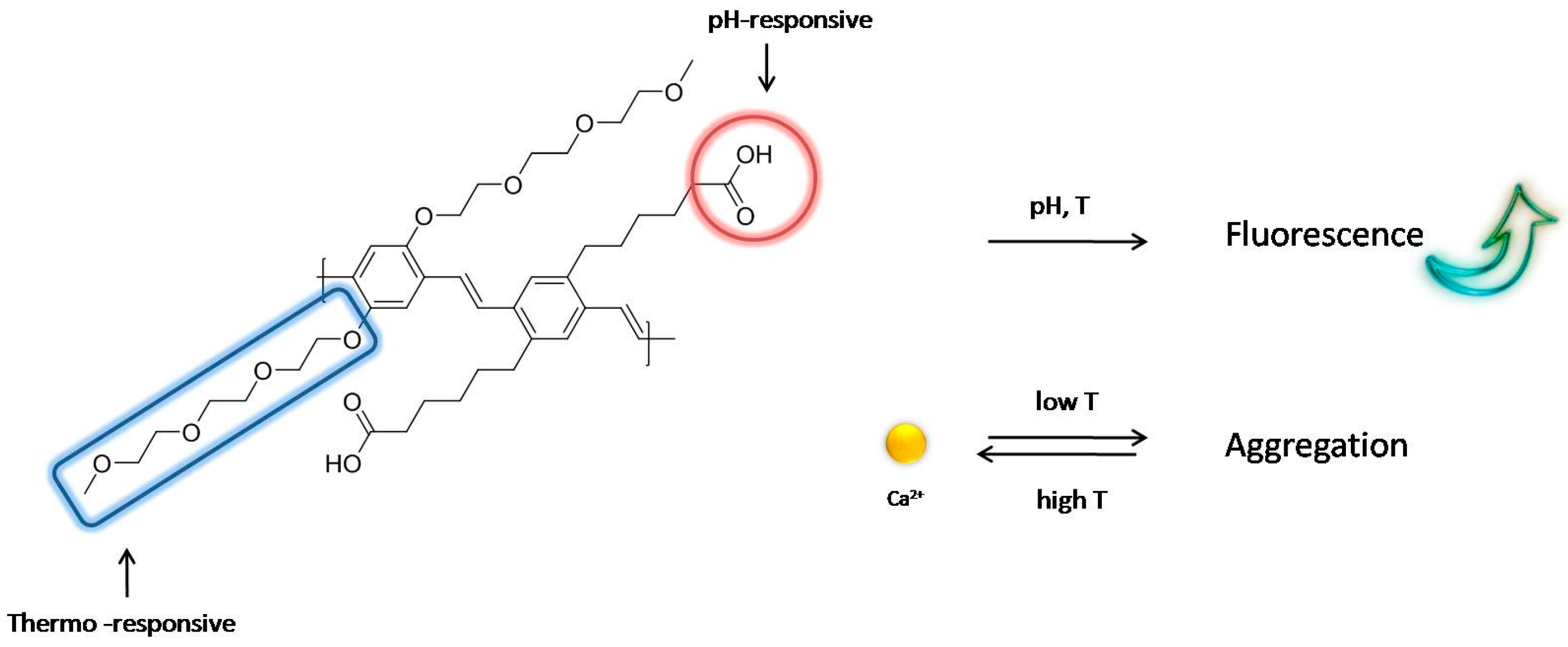

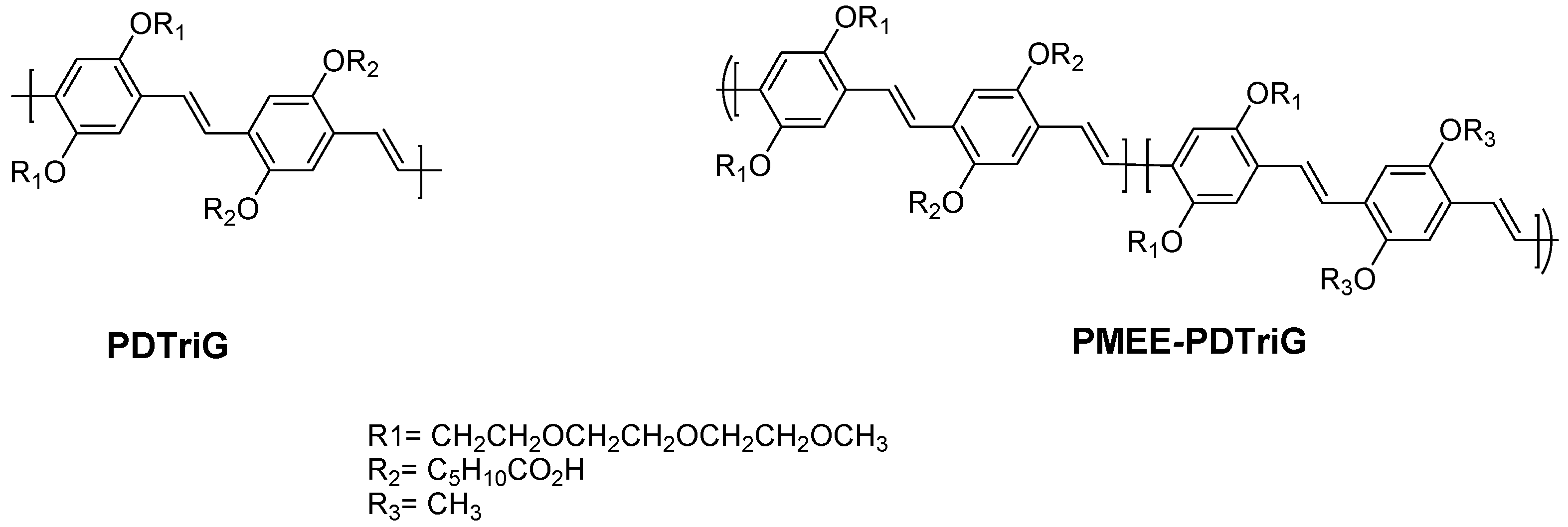
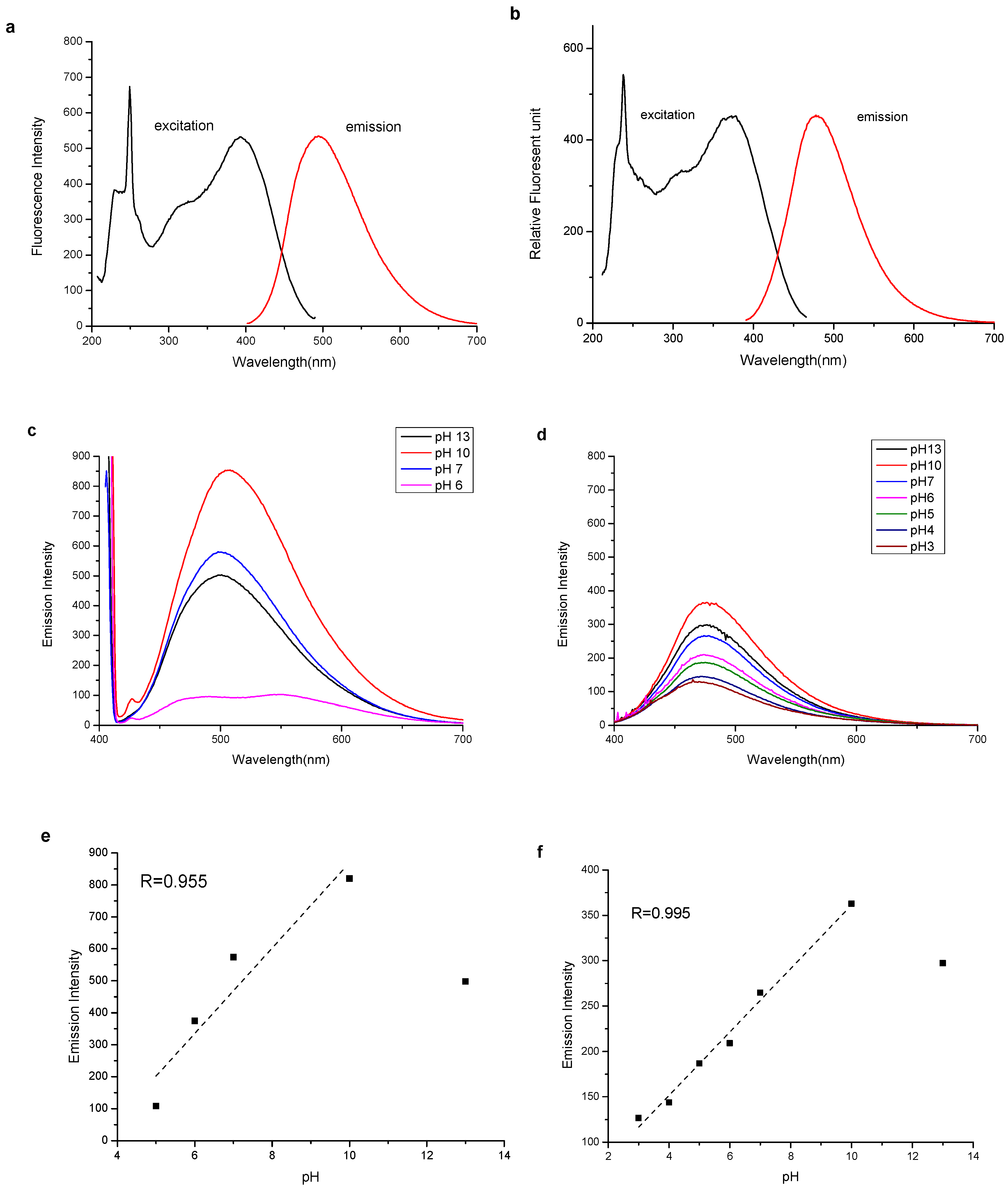
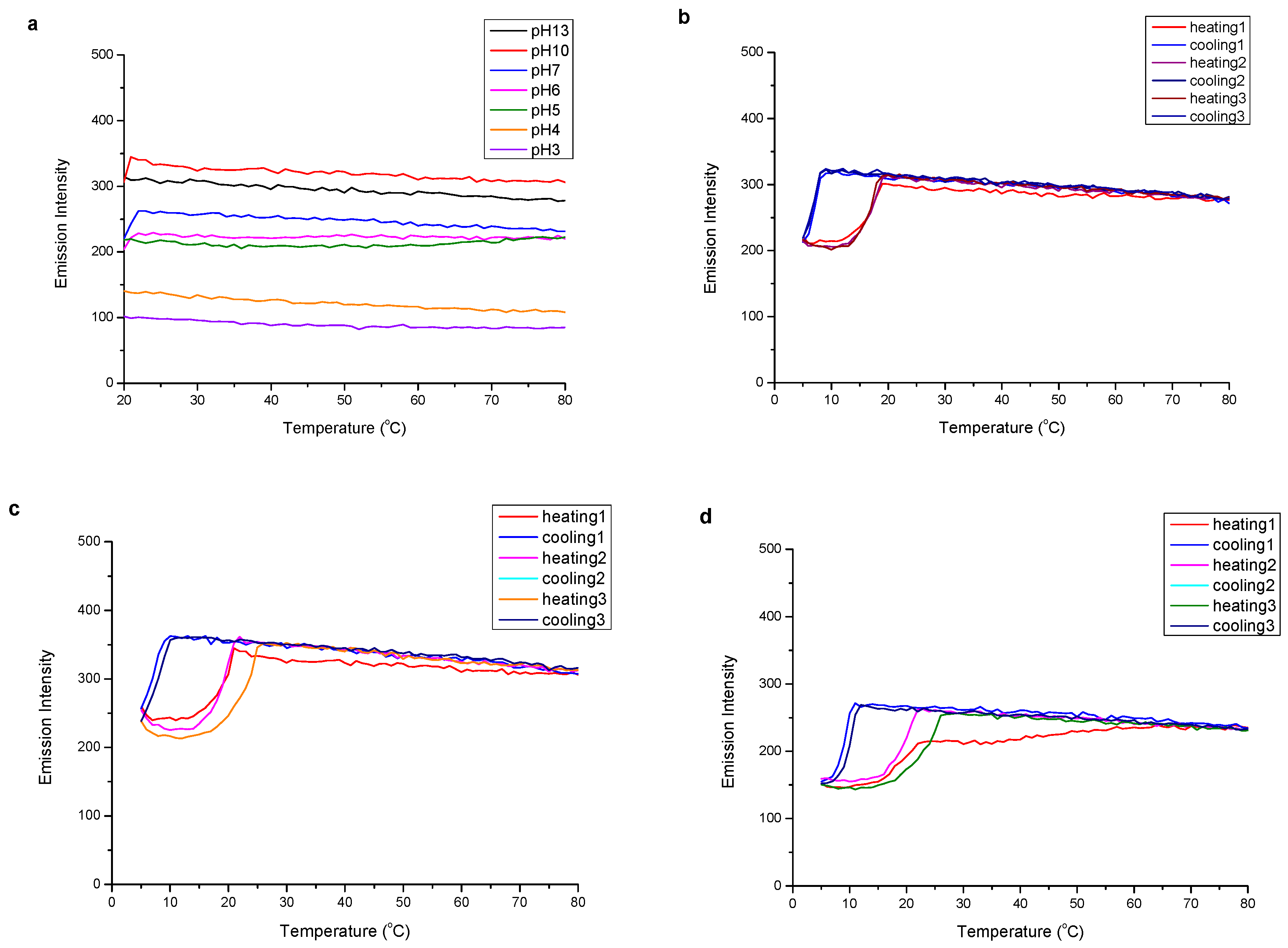
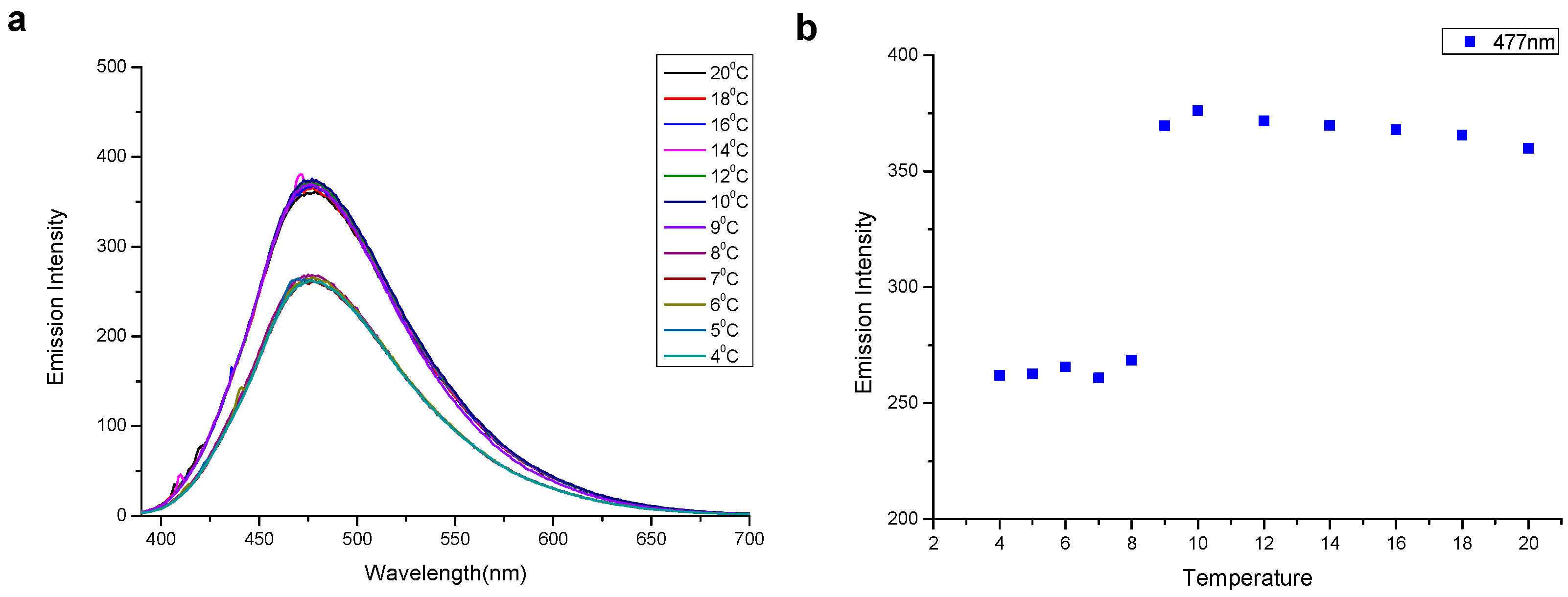
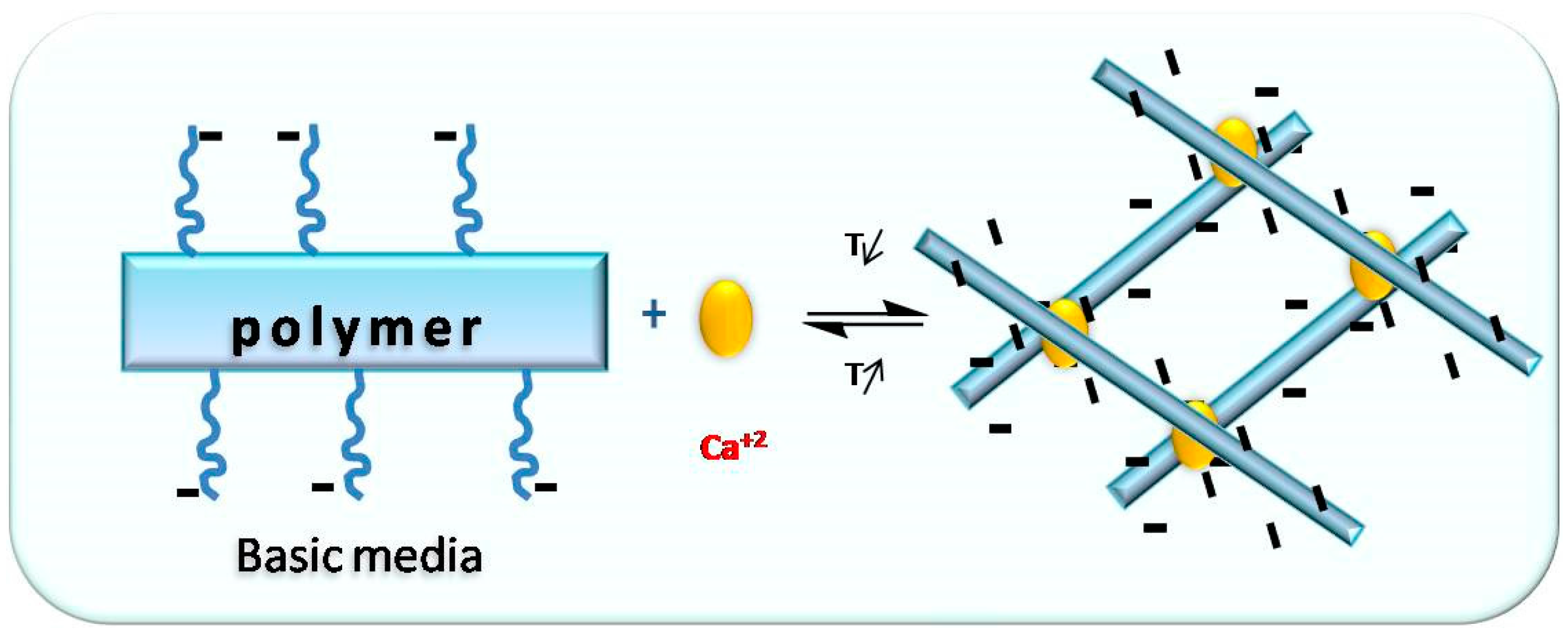
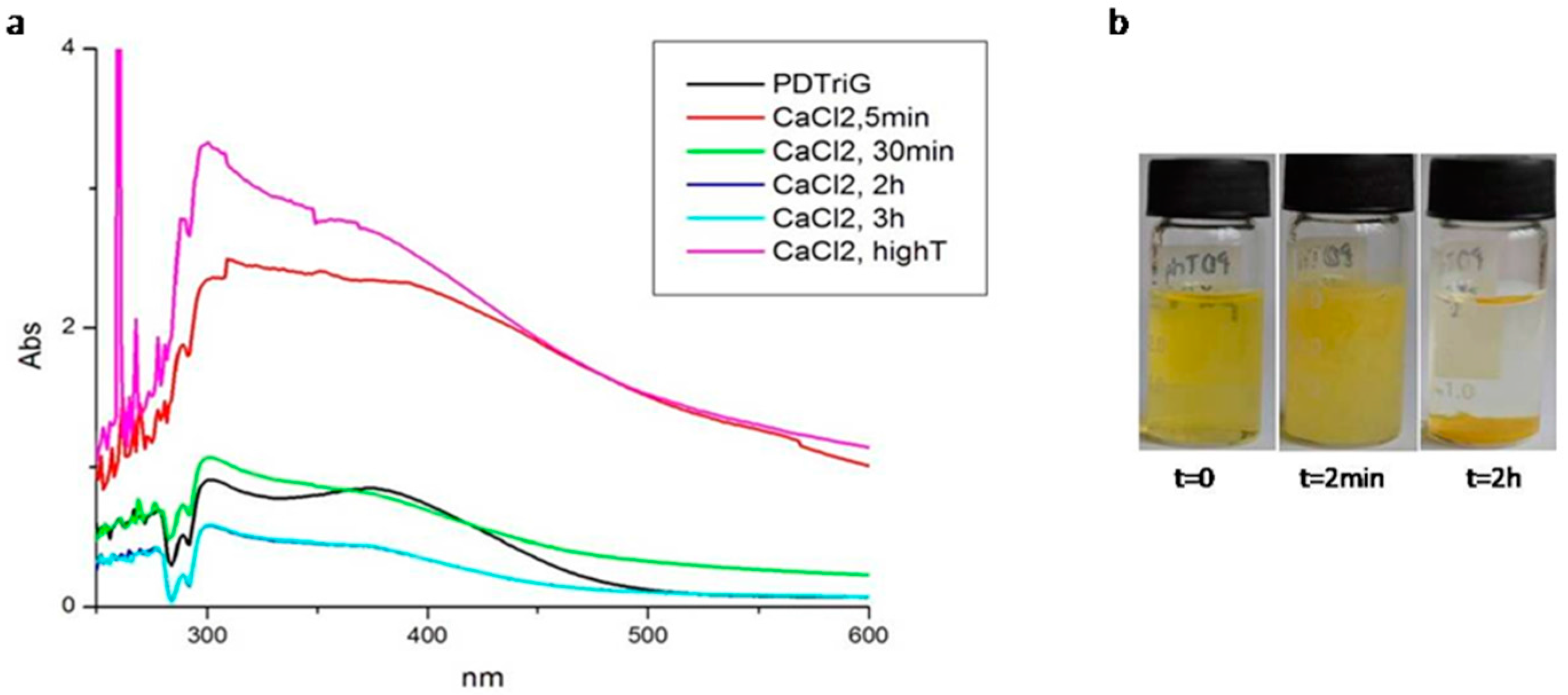
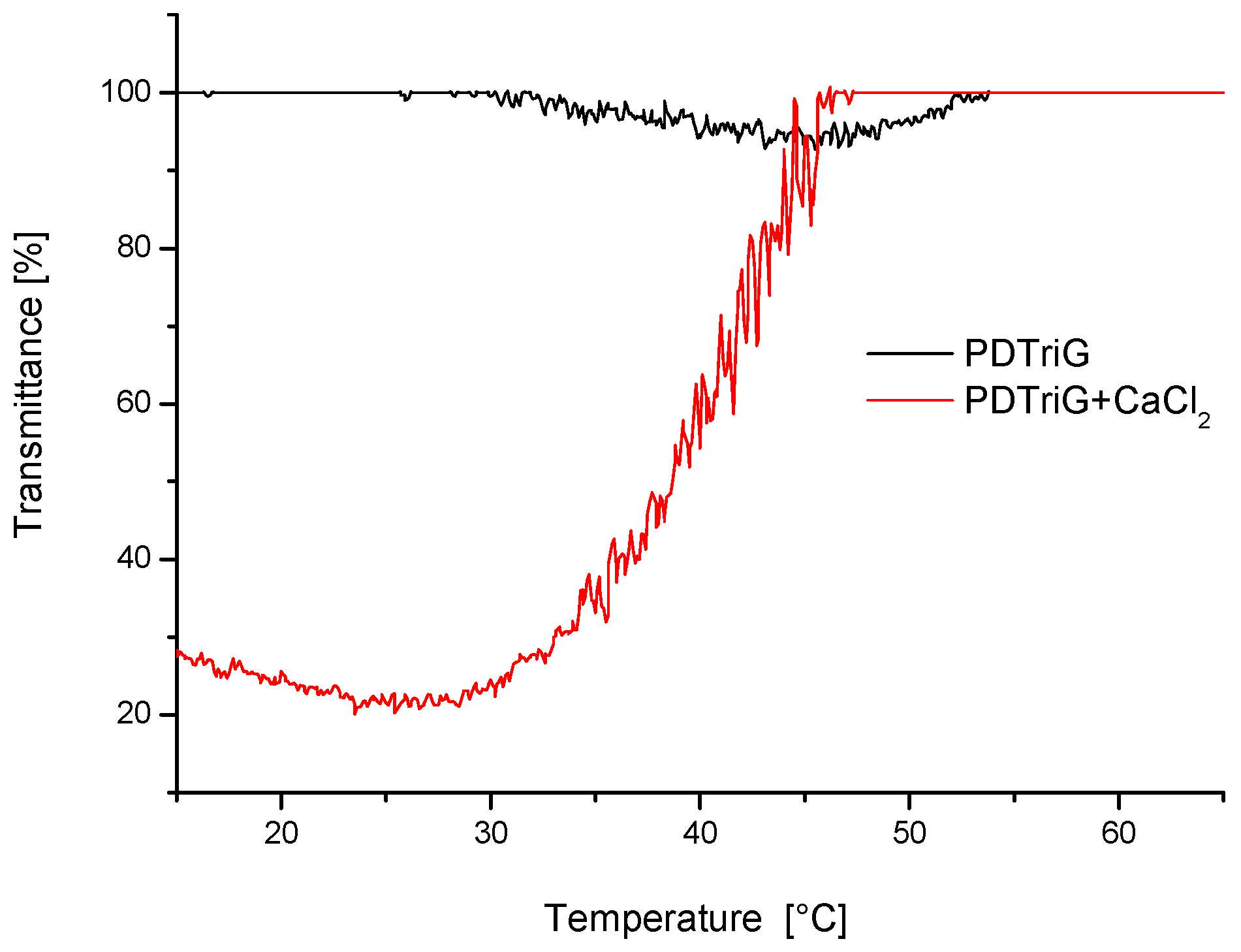
© 2016 by the authors. Licensee MDPI, Basel, Switzerland. This article is an open access article distributed under the terms and conditions of the Creative Commons Attribution (CC-BY) license ( http://creativecommons.org/licenses/by/4.0/).
Share and Cite
Ryskulova, K.; Rao Gulur Srinivas, A.; Kerr-Phillips, T.; Peng, H.; Barker, D.; Travas-Sejdic, J.; Hoogenboom, R. Multiresponsive Behavior of Functional Poly(p-phenylene vinylene)s in Water. Polymers 2016, 8, 365. https://doi.org/10.3390/polym8100365
Ryskulova K, Rao Gulur Srinivas A, Kerr-Phillips T, Peng H, Barker D, Travas-Sejdic J, Hoogenboom R. Multiresponsive Behavior of Functional Poly(p-phenylene vinylene)s in Water. Polymers. 2016; 8(10):365. https://doi.org/10.3390/polym8100365
Chicago/Turabian StyleRyskulova, Kanykei, Anupama Rao Gulur Srinivas, Thomas Kerr-Phillips, Hui Peng, David Barker, Jadranka Travas-Sejdic, and Richard Hoogenboom. 2016. "Multiresponsive Behavior of Functional Poly(p-phenylene vinylene)s in Water" Polymers 8, no. 10: 365. https://doi.org/10.3390/polym8100365






